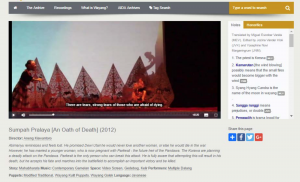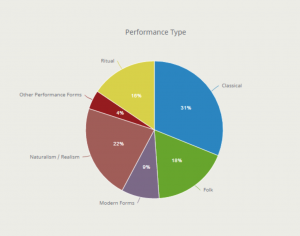Contextualization Tools for Digital Archives
This presentation argues that providing contextual information is a key feature of digital archives. Three case studies are used to illustrate conceptual and technical challenges arising from this feature.
In the digital humanities, digital archives often blend features of archiving and editing (Price 2009). The primary mission of archives is not to present a consistent impartial group of records, but to offer contextual information for a large selection of records. Perhaps the archiving principle of respect des fonds [respect for the structure of the records] should be reimagined as context des fonds [context of the records]. This paper considers the implications of this new archiving maxim by analyzing three digital archives of Asian theatre performances: the Asian Shakespeare Intercultural Archive (A|S|I|A), The Contemporary Wayang Archive (CWA) and Theatre Makers Asia (TMA). Although all three archives were developed jointly at the National University of Singapore, they each respond to different needs in archival practice and include different contextualization tools. A contextualization tool is defined here as a widget, embedded panel or interactive display of a website that provides context for the users of an online archive.
The Contemporary Wayang Archive (CWA) is a collection of re-elaborations of Java’s oldest and most important performance tradition: wayang kulit [leather puppets]. It includes performance data, translations and notes on how the performances were received in their original context. Besides conventional metadata (author, place and time of recording), each performance record includes a short summary and interpretive tags that specify the type of music, performance space, puppets used and languages spoken in each performance. This metadata forms part of a digital ecosystem of contextualization, that can be accessed by the users in several ways:
1) A list of all the recordings, where selected metadata tags are displayed. A user can hover the mouse over the tags for a description.
2) Individual recording pages, where all metadata items and the summary are displayed. The video can be played and a side panel includes notes on the translation of the performances, as well as a list of honorifics
(Fig. 1). The notes include word play, cultural and historical allusions, and ambiguous expressions are explained in the notes. A number in brackets in the subtitles refers to the note number that can be found in the note box next to the video player. The translations aim for simplicity in order to allow users to easily watch the performance videos. However, the honorifics in the original languages were retained in the subtitles. In Javanese and Indonesian, speakers address their interlocutors with over 40 different honorifics which denote differences in their relative status and level of intimacy.
3) A (forthcoming) SPARQL endpoint where the semantic data can be queried directly or linked into federated data collections.

Figure 1. A screenshot of the Contemporary Wayang Archive. Video player, metadata and note panel.
The archive provides interaction paths for different kinds of users. People with little expertise in Javanese theatre can read introductory sections, use the tag navigator to find performances and watch the videos while reading the contextual notes and honorifics. Advanced users can use the concordance search to find specific passages in the transcripts, or watch the performances in full screen mode, with transcripts or with no subtitles. These contextual tools can be turned on and off according to the users’ needs.
The objective of A|S|I|A is to provide “the basis for an accurate, contextualized and comparative experience of Asian Shakespeare performances.” This approach is implemented in the main contextualization tools of the archive: interactive concept maps. These maps reflect culturally-specific choices in the theatrical forms, points of reference, staging strategies and approaches to adapting Shakespeare in over sixty performances. The high degree of nuance in these data points can be explored through the interactive map in relation to specific performances. However, the aggregate of this interpretive data can also be visualized through comparative pie charts that show the distribution of categories across the records in the archive (Fig.2).

Figure 2. Screenshot of A|S|I|A, a pie chart shows the distribution of performance types.
Another contextualization tool is the presence of multiple languages: Chinese, Japanese, Korean and English. The A|S|I|A website itself represents an exploration of intercultural practices for the digital archiving of performance since its four parallel language environments are fully equivalent and users can switch between them at any time. The subtitles and contextual data are consistently translated across these languages. In other words, the kind of context provided by the archive is not generic for all website visitors, but tailored to the language preferences of individual users. Lastly, users can add their own data through another contextualization tool: a time-based annotation panel, where users can comment on specific moments of a performance. These comments can be made public or restricted to private groups. But in either case, they provide the users with a way to augment the archive with their own set of contextual notes.
TMA, in contrast, aims to experiment with digital archives as platforms for collaborative research and creative responses. The collection of the archive focuses on the history of contemporary theatre in East and Southeast Asia. Rather than organize the archive material according to invariant structural principles, the records can be organized into exhibitions. Some of these will be curated by guest researchers, but individual users can create their own exhibitions. The exhibition is another kind of contextual tool, where context is dynamically recreated as the result of considering the performances in dialogue with one another.
As seen in this overview, contextualization poses technical and conceptual challenges for digital archives. Conceptually, it forces the makers of archives to interrogate the ontology of their creations: are they collecting comprehensive storehouses of records or scholarly introductions to little-known themed collections? The answers to this question can lead to a wide array of technical implementations of contextual tools. Even within a narrow field, such as Asian performances, a single solution will be impossible. The future of archives as useful resources lies in a plurality of approaches.
Works Cited
Kenneth M. Price (2009). Edition, Project, Database, Archive, Thematic Research Collection: What’s in a Name? Digital Humanities Quarterly Volume 3, Number 3.
